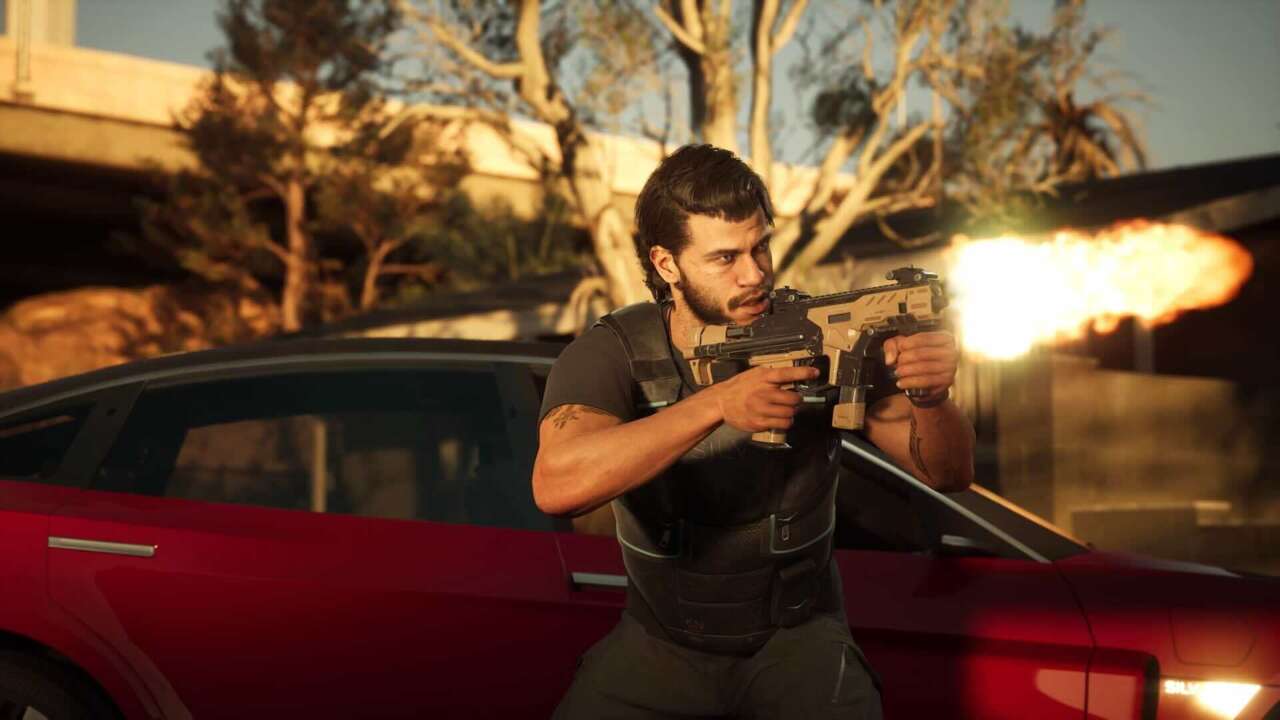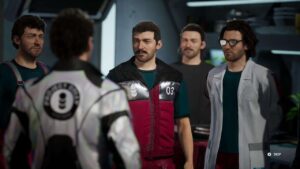One of the earliest missions in MindsEye tasks you with tailing a car. Get too close and the person driving will spot you; fall too far behind and you’ll lose sight of the vehicle. It’s the exact kind of mission structure we all decided was tired and needed to go away over a decade ago. The only difference in MindsEye is that you’re piloting a drone instead of driving a car, so even the relatively small stakes are diminished by the fact that you can just fly really high to avoid being seen. It’s not a positive first impression, especially when you factor in the confluence of concerning events surrounding the game and developer Build a Rocket Boy–from the studio’s co-CEO stating that anyone sharing negative feedback about the game was being funded by an ubiquitous source, to the chief legal officer and CFO both leaving the company a few weeks before launch.
Neither is a great look, yet I still went into MindsEye with an open mind. There’s some pedigree behind the scenes, after all, with former Rockstar North lead Leslie Benzies handling directing duties. Benzies was a producer on Grand Theft Auto III through V before leaving to found Build a Rocket Boy, and you can clearly see elements of GTA’s DNA in MindsEye. Unfortunately, the comparisons end there.
MindsEye is not good. That early tailing mission is sadly indicative of the rest of the game as you slog through roughly 10 hours of dull and creatively bankrupt third-person action, combining driving and cover-based shooting within a linear framework. The story isn’t completely terrible, at least, with a few entertaining moments sprinkled into what is otherwise a mostly forgettable tale. You play as Jacob Diaz, a former soldier with selective amnesia caused by a neural implant in his neck: the titular MindsEye. What initially begins as a personal quest to uncover his past gradually becomes a mission for humanity’s survival, as familiar sci-fi tropes come to the fore.
Gallery
Set in a near-future that’s easy to imagine becoming reality, MindsEye touches on some potentially interesting topics, with an algorithm in charge of public safety and unchecked military power among them. However, each of these concepts is quickly disregarded as a minor background detail, never explored beyond the surface level. We already live in a world where the concerning use of AI extends to tackling crime, and the foibles of robotic cops aren’t any more frightening than what human police are already doing, so electing to bring up these subjects without having anything to say is disappointing and blunts the story’s impact.
Jacob is also one of the most generic protagonists you could ask for, with no memorable characteristics beyond a frustrating naivety that never comes back to bite him. This is because most of the other characters are exactly who they say they are. There’s no intrigue, and characters lack emotional depth and development, so it’s hard to empathize with or care about what happens to any of them. They’re not likable or interesting, and even the antagonists are unceremoniously killed in cutscenes just when it looks like you might get thrown into a boss fight.
It’s a shame because, visually, the world and character models are impressive. The actors do a decent-enough job with the material they’re given, too, although there are still a few moments when their line deliveries feel chopped up and mashed together, preventing scenes from flowing like an actual conversation would. The game’s ending is also so abrupt, anti-climactic, and unsatisfying that I couldn’t help but laugh at how ridiculous it is.

The fictional city of Redrock does at least have some semblance of style. MindsEye’s setting is clearly based on Las Vegas, with replicas of the Luxor pyramid, Allegiant Stadium, and the Sphere among its borrowed landmarks. It feels futuristic, yet also credible as the type of city we might see in a few years’ time. Look beyond the casinos and skyscrapers, and you’ll find strip malls, condos, and regular neighborhoods: locales that wouldn’t look out of place in the present day, save for the appearance of high-tech drones and robots. It’s a glimpse into the future, but one that’s conceivable and thus recognizable.
The praise stops here, however. While the amount of effort that went into creating Redrock is apparent, it ultimately feels wasted. MindsEye is not the open-world game it may appear to be from the outside. These are glimpses of GTA DNA, but ultimately, it’s remarkably rigid and linear. In almost every mission, you’re given a designated vehicle to drive–others are off-limits and you can’t exit the one you’re in, even if it’s on fire–and must then head from point A to B. You’re actively discouraged from exploring, as the game will incessantly scold you before failing the mission if you veer too far off course. Not that there’s anything waiting for you if you do decide to venture from your GPS heading. There aren’t even any consequences for your actions. Crash into a bunch of cars or run over pedestrians and the world won’t react. The police don’t even respond if you commit crimes, so the whole thing feels empty and devoid of life, like you’re on a film set and nothing’s real. Redrock is little more than a flimsy backdrop for the most boring, straightforward missions imaginable.
When you’re not mindlessly driving from one location to the next, MindsEye occasionally drops you into protracted car chases where the most excitement you might find is from seeing another vehicle randomly explode. These chases aren’t all that different from your regular commute, as both end with a cutscene once you’ve reached a specific location. Nothing you do has any bearing on the outcome–you’re basically following a car until the game decides you’re done–but at least the vehicle handling can be somewhat fun. It’s easy to fly into high-speed handbrake turns, and the cars don’t feel like they’re superficially stuck to the road, so weaving through traffic is viable. There’s a palpable sense of weightlessness to each vehicle, though, so it doesn’t take much to flip a car with how uneven the physics engine is. In most other games, this wouldn’t be a problem, but it is when you’re not allowed to exit a car and find a new one. The sad thing is, once you are on foot, you’ll be begging to get back behind the wheel.
MindsEye is a cover shooter where cover rarely feels necessary. This is primarily due to the brain-dead enemy AI, which suffers from numerous issues that stifle what is already a bare-bones combat experience. When they’re not standing still, mindlessly running toward you, or instantly blinking in and out of cover with no animation linking these two stages together, enemies will often flee in one direction while firing in another, causing bullets to exit their barrels at impossible angles. Other times, enemies startlingly slow to react to you, especially if you run up beside them, and they’re about as accurate as a Stormtrooper with their helmet on backwards. You can even side-step bullets because of how slowly they travel toward you. Couple this with a brief time-to-kill, and it’s easy enough to stand in the open and mow down every enemy before they’re able to deplete your health bar. There’s no discernible difference between the medium and hard difficulty modes, either, try as I might to create some sort of challenge to make combat the least bit engaging. No such luck.


Even disregarding the AI, combat is stilted and lacks dynamism on a foundational level. There are no melee attacks, and additional tools like grenades aren’t unlocked until the very end of the game, and even then they’re frustrating to use because you don’t have direct aiming control without switching to a companion drone that follows you around. You can’t even blindfire from cover or use evasive maneuvers, such as rolling. Your options in a fight are extremely limited, and the guns at your disposal lack impact due to the game’s muted sound design and inadequate enemy reactions. Weapons also have a habit of appearing in your weapon wheel with no fanfare. I usually didn’t know I had new firearms until I noticed them in my inventory. The only time this differed was when MindsEye asked me to use a specific weapon that I didn’t even have in my inventory.
The entire game is relentlessly bland, adopting a formula seemingly designed to test how well you can stay awake while playing it. Many missions feel padded out just to justify the game’s price. I can’t count the number of times I drove somewhere for five minutes, engaged in a boring gunfight, then drove for another five minutes to watch an inconsequential cutscene. MindsEye deviates from this blueprint on a few occasions, but the results are equally bad. There’s an obligatory overdrawn stealth section where you spend most of your time waiting for the slowest robots in the world to pass so you can slip by. One mission has you fly a tiny drone into a woman’s apartment and essentially pixel-hunt for the right objects. There are even irritating one-off minigames for performing CPR and digging your own grave. Meanwhile, MindsEye’s most interesting set pieces are relegated to cutscenes.
Then there are these weird side missions that are only tangentially related to the plot. They transport you into either the past or the future, usually to complete a brief shootout that rewards you with a medal depending on how quickly you can kill everyone. There are no other benefits to doing these or improving your times. They’re just for the “fun” of it. The kicker is that you can also create these short missions yourself, using building tools that are currently in beta. This seems like a holdover or proof-of-concept for Everywhere, Build a Rocket Boy’s previously announced metaverse-adjacent project. The tools look daunting and are probably involved, but I didn’t have the patience to learn how to make missions that I didn’t enjoy playing in the first place.
MindsEye is not the worst game ever made, but I also seem to have come away mostly unscathed in terms of its potential technical issues. The internet is already awash with examples of glitches and performance problems, but occasional stuttering was the worst thing I experienced on PC. Still, even if you manage to achieve a stable experience, MindsEye still commits the cardinal sin of being mind-numbingly boring. More than anything, it feels like a game firmly trapped in the past. It wouldn’t have been good 15 years ago, either, but perhaps some of its design choices would have made more sense. As it is, issues like broken AI and uneven car physics simply exacerbate the problems with its archaic and insipid design. Impressive visuals can’t compensate for a lack of substance, whether that comes from its pointless world, tedious combat, or any number of other egregious shortcomings. If you’re looking for quality, cast your mind’s eye elsewhere.









